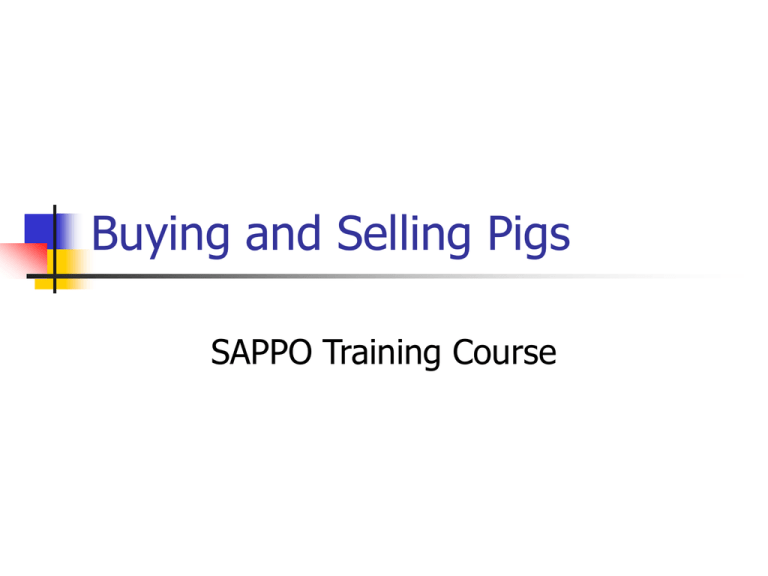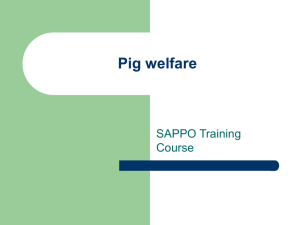Buying-and-Selling-Pigs
advertisement

Buying and Selling Pigs SAPPO Training Course Buying pigs Whether you are buying pigs to start pig farming, to replace stock or to increase the size of your herd, there are some factors besides price that must be considered in order to avoid losses and disappointment It is better to pay a higher price for a good pig than to pay a low price and lose the money because the pig dies or fails to perform as you would expect it to Sources of pigs for sale Recognised breeders Live auctions The most reliable source for buying good quality breeding stock Risky unless you know the herd of origin and the pig is accompanied by a veterinary health certificate Friends and neighbours No problem as long as you know their pigs are healthy and productive and their reason for selling pigs Some tips for buying pigs NEVER buy pigs from a doubtful source like a travelling speculator or at the roadside ALWAYS examine the pig carefully to make sure that it is healthy Remember that there are regulations for moving pigs, make sure that you comply with any requirements for a movement permit Do not buy from these… Selling pigs There are various options: Selling weaners to another producer for growing out (if you cannot afford to feed them until they reach market weight) Porkers – 60-70 kg live mass Baconers – 75-100 kg live mass Cull sows and boars (do not keep breeders past their sell-by date) Guidelines for selling pigs Class of pig Weaners Weaners Porkers Baconers Cull adults Live mass Observations 9-10 kg (6 weeks) Good for cash flow 25 kg (10-12 See next slide weeks) for price Up to 70 kg (55 Sell as heavy as kg carcass) possible 75-95 kg (56-72 Sell as heavy as kg carcass) possible Not applicable Price negotiable Guidelines for prices Formula to negotiate price for weaners: 9-10 kg: Current baconer price per kg x 24* 25 kg: Current baconer price per kg x 30* Sell porkers and baconers as heavy as possible within their class Price per kg for baconers usually slightly lower than for porkers Price for cull animals negotiable on age and condition *Suggested figures, but prices always negotiated Where/how to market pigs Agents Work on producers’ behalf at large abattoirs Make arrangements at abattoir (pay fees etc.) Obtain best price for pigs on day of sale Charge a fee for their services Where/how to market pigs Private contract Must produce good pigs consistently Contract with butcher or distributor to buy your pigs at a stable, negotiated price for an agreed period of time Protects against daily variations in market price Where/how to market pigs Live auctions Can sell mixed batches of pigs of varying quality Pigs will require movement permits and identification (tattoos) Price depends on what bidders are prepared to offer Where/how to market pigs Other options Direct sales to small abattoirs as pigs become available Private local sales of live pigs Home slaughter Must comply with provisions of Animal Protection Act Meat may not be offered for sale if not inspected and passed by a meat inspector Legal requirements Make sure that you know and comply with the legal requirements for: Sale of pigs for human consumption Movement of pigs Identification of pigs that move (ear tattoo) Home slaughter Any questions?




